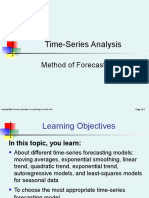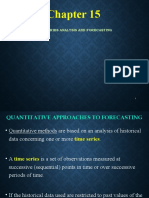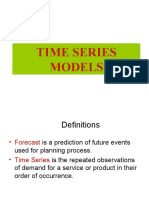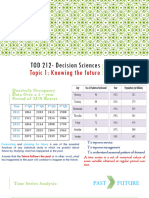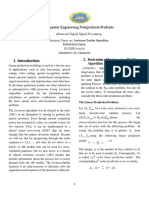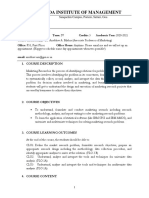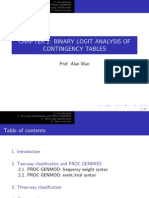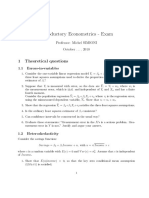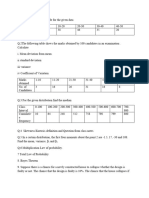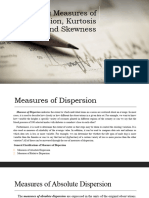Chapter 16 16-1
Statistics for
Business and Economics
8th Global Edition
Chapter 8
Forecasting with Time-Series
Models
Copyright © 2013 Pearson Education Ch. 16-1
Chapter Goals
After completing this chapter, you should be able to:
Identify the trend, seasonality, cyclical, and irregular
components in a time series
Use smoothing-based forecasting models, including
moving average and exponential smoothing
Apply autoregressive models and autoregressive
integrated moving average models
Copyright © 2013 Pearson Education Ch. 16-2
Statistics for Business and Economics, 8/e Copyright © 2013 Pearson Education
� Chapter 16 16-2
Introduction
Time-Series Data
Numerical data ordered over time
The time intervals can be annually, quarterly,
daily, hourly, etc.
The sequence of the observations is important
Example:
Year: 2008 2009 2010 2011 2012
Sales: 75.3 74.2 78.5 79.7 80.2
Copyright © 2013 Pearson Education Ch. 16-3
16.1
Components of a Time Series
Time Series
Trend Seasonality Cyclical Irregular
Component Component Component Component
Copyright © 2013 Pearson Education Ch. 16-4
Statistics for Business and Economics, 8/e Copyright © 2013 Pearson Education
� Chapter 16 16-3
Time-Series Plot
A time-series plot is a two-dimensional
plot of time-series data
the vertical axis
measures the variable
of interest
the horizontal axis
corresponds to the
time periods
Copyright © 2013 Pearson Education Ch. 16-5
Trend Component
Long-run increase or decrease over time
(overall upward or downward movement)
Data taken over a long period of time
Sales
Copyright © 2013 Pearson Education
Time Ch. 16-6
Statistics for Business and Economics, 8/e Copyright © 2013 Pearson Education
� Chapter 16 16-4
Trend Component
(continued)
Trend can be upward or downward
Trend can be linear or non-linear
Sales Sales
Time Time
Downward linear trend Upward nonlinear trend
Copyright © 2013 Pearson Education Ch. 16-7
Seasonal Component
Short-term regular wave-like patterns
Observed within 1 year
Often monthly or quarterly Year n+1
Year n
Sales
Summer
Winter
Summer
Winter Spring Fall
Spring Fall
Time (Quarterly)
Copyright © 2013 Pearson Education Ch. 16-8
Statistics for Business and Economics, 8/e Copyright © 2013 Pearson Education
� Chapter 16 16-5
Cyclical Component
Long-term wave-like patterns
Regularly occur but may vary in length
Often measured peak to peak or trough to
trough
1 Cycle
Sales
Year
Copyright © 2013 Pearson Education Ch. 16-9
Irregular Component
Unpredictable, random, “residual” fluctuations
Due to random variations of
Nature
Accidents or unusual events
“Noise” in the time series
Copyright © 2013 Pearson Education Ch. 16-10
Statistics for Business and Economics, 8/e Copyright © 2013 Pearson Education
� Chapter 16 16-6
Time-Series Component Analysis
Used primarily for forecasting
Observed value in time series is the sum or product of
components
Additive Model Multiplicative model
(linear in log form)
X t Tt S t C t It X t Tt S t C tIt
where Xt = value of the time series at time t
Tt = Trend component at period t
St = Seasonality component for period t
Ct = Cyclical component at time t
It = Irregular (random) component for period t
Copyright © 2013 Pearson Education Ch. 16-11
16.2
Moving Averages
Calculate moving averages to get an overall
impression of the pattern of movement over
time
This smooths out the irregular component
Moving Average: averages of a designated
number of consecutive
time-series values
Copyright © 2013 Pearson Education Ch. 16-12
Statistics for Business and Economics, 8/e Copyright © 2013 Pearson Education
� Chapter 16 16-7
(2m+1)-Point Moving Average
A series of arithmetic means over time
Result depends upon choice of m (the
number of data values in each average)
Examples:
For a 5 year moving average, m = 2
For a 7 year moving average, m = 3
Etc.
Replace each xt with
m
1
X*t X t j (t m 1, m 2,,n m)
2m 1 j m
Copyright © 2013 Pearson Education Ch. 16-13
Moving Averages
Example: Five-year moving average
First average:
x1 x 2 x 3 x 4 x 5
x 3*
5
Second average:
x2 x3 x 4 x5 x6
x *4
5
etc.
Copyright © 2013 Pearson Education Ch. 16-14
Statistics for Business and Economics, 8/e Copyright © 2013 Pearson Education
� Chapter 16 16-8
Example: Annual Data
Year Sales
1 23
2 40
3 25
4 27 …
5 32
6 48
7 33
8 37
9 37
…
10 50
11 40
etc… etc…
Copyright © 2013 Pearson Education Ch. 16-15
Calculating Moving Averages
Let m = 2 5-Year
Average Moving
Year Sales Year Average
1 23 23 40 25 27 32
3 29.4 29.4
5
2 40 4 34.4
3 25 5 33.0
4 27 6 35.4
5 32 7 37.4
6 48 8 41.0
7 33 9 39.4
8 37 etc… … …
9 37
10 50 Each moving average is for a
11 40 consecutive block of (2m+1) years
Copyright © 2013 Pearson Education Ch. 16-16
Statistics for Business and Economics, 8/e Copyright © 2013 Pearson Education
� Chapter 16 16-9
Annual vs. Moving Average
The 5-year
moving average
smoothes the
data and shows
the underlying
trend
Copyright © 2013 Pearson Education Ch. 16-17
Centered Moving Averages
Let the time series have period s, where s is even
number
i.e., s = 4 for quarterly data and s = 12 for monthly data
To obtain a centered s-point moving average series
Xt*:
Form the s-point moving averages
s/2
x
j (s/2)1
t j
s s s s
*
x t 0.5 (t , 1, 2,,n )
s 2 2 2 2
Form the centered s-point moving averages
x *t 0.5 x *t 0.5 s s s
x *t (t 1, 2,, n )
2 2 2 2
Copyright © 2013 Pearson Education Ch. 16-18
Statistics for Business and Economics, 8/e Copyright © 2013 Pearson Education
� Chapter 16 16-10
Centered Moving Averages
Used when an even number of values is used in the moving
average
Average periods of 2.5 or 3.5 don’t match the original
periods, so we average two consecutive moving averages to
get centered moving averages
4-Quarter Centered
Average Moving Centered Moving
Period Average Period Average
2.5 28.75 3 29.88
3.5 31.00 4 32.00
4.5 33.00 5 34.00
5.5 35.00 etc… 6 36.25
6.5 37.50 7 38.13
7.5 38.75 8 39.00
8.5 39.25 9 40.13
9.5 41.00
Copyright © 2013 Pearson Education Ch. 16-19
Seasonal Index Method
Goal: estimate the seasonal impact
Assume a stable seasonal pattern over time
For any month or quarter in each year, the effect of
seasonality is to increase or decrease the series by
the same percentage
Divide the actual sales value by the centered
moving average for that period
xt
100
x *t
Copyright © 2013 Pearson Education Ch. 16-20
Statistics for Business and Economics, 8/e Copyright © 2013 Pearson Education
� Chapter 16 16-11
Calculating a Seasonal Index
Centered Ratio-to-
Moving Moving
Quarter Sales Average Average
1 23
2 40
3 25 29.88 83.7 x 25
100 3* 100 83.7
4 27 32.00 84.4 x
3 29.88
5 32 34.00 94.1
6 48 36.25 132.4
7 33 38.13 86.5
8 37 39.00 94.9
9 37 40.13 92.2
10 50 etc… etc…
11 40 … …
… … … …
Copyright © 2013 Pearson Education Ch. 16-21
Calculating a Seasonal Index
(continued)
Centered Ratio-to-
Moving Moving
Quarter Sales Average Average
1 23
2 40
Fall 3 25 29.88 83.7 1. Find the median
4 27 32.00 84.4 of all of the
5 32 34.00 94.1 same-season
6 48 36.25 132.4 values
Fall 7 33 38.13 86.5 2. Adjust so that
8 37 39.00 94.9
the average over
9 37 40.13 92.2
10 50 etc… etc…
all seasons is
Fall 11 40 … … 100
… … … …
Copyright © 2013 Pearson Education Ch. 16-22
Statistics for Business and Economics, 8/e Copyright © 2013 Pearson Education
� Chapter 16 16-12
Interpreting Seasonal Indexes
Suppose we get these
seasonal indexes:
Seasonal Interpretation:
Season
Index
Spring sales average 82.5% of the
Spring 0.825 annual average sales
Summer sales are 31.0% higher
Summer 1.310
than the annual average sales
Fall 0.920 etc…
Winter 0.945
= 4.000 -- four seasons, so must sum to 4
Copyright © 2013 Pearson Education Ch. 16-23
16.3
Exponential Smoothing
A weighted moving average
Weights decline exponentially
Most recent observation weighted most
Used for smoothing and short term
forecasting (often one or two periods into
the future)
Copyright © 2013 Pearson Education Ch. 16-24
Statistics for Business and Economics, 8/e Copyright © 2013 Pearson Education
� Chapter 16 16-13
Exponential Smoothing
(continued)
The weight (smoothing coefficient) is
Subjectively chosen
Range from 0 to 1
Smaller gives more smoothing, larger
gives less smoothing
The weight is:
Low value (closer to 0) for smoothing out
unwanted cyclical and irregular components
Higher value (closer to 1) for forecasting,
especially for smoother time series
Copyright © 2013 Pearson Education Ch. 16-25
Exponential Smoothing Model
1. Obtain the smoothed series:
xˆ 1 x1 xˆ t (1 α ) xˆ t 1 (α )x t (0 α 1; t 2,3,, n)
2. From time n, the forecasts of future values are
xˆ nh xˆ n (h 1,2,)
where:
x̂ t = exponentially smoothed value for period t
x̂ t -1 = exponentially smoothed value already
computed for period i - 1
xt = observed value in period t
= weight (smoothing coefficient), 0 < < 1
Copyright © 2013 Pearson Education Ch. 16-26
Statistics for Business and Economics, 8/e Copyright © 2013 Pearson Education
� Chapter 16 16-14
Exponential Smoothing Example
Suppose we use weight = 0.2 xˆ t (1 0.2) xˆ t 1 0.2x t
Time Forecast
Sales Exponentially Smoothed
Period from prior
(Xt) Value for this period (x̂ t )
(t) period (x̂ t -1 )
1 23 -- 23 x̂1 = x1
2 40 23 (.8)(23)+(.2)(40)=26.4 since no
3 25 26.4 (.8)(26.4)+(.2)(25)=26.12 prior
information
4 27 26.12 (.8)(26.12)+(.2)(27)=26.296 exists
5 32 26.296 (.8)(26.296)+(.2)(32)=27.437
6 48 27.437 (.8)(27.437)+(.2)(48)=31.549
7 33 31.549 (.8)(31.549)+(.2)(33)=31.840
8 37 31.840 (.8)(31.840)+(.2)(37)=32.872
9 37 32.872 (.8)(32.872)+(.2)(37)=33.697
10 50 33.697 (.8)(33.697)+(.2)(50)=36.958
etc. etc. etc. etc.
Copyright © 2013 Pearson Education Ch. 16-27
Sales vs. Smoothed Sales
Fluctuations
have been
60
smoothed
50
40
NOTE: the
Sales
30
smoothed value in
20
this case is
generally a little low, 10
since the trend is 0
upward sloping and 1 2 3 4 5 6 7 8 9 10
Time Period
the weighting factor
Sales Smoothed
is only 0.2
Copyright © 2013 Pearson Education Ch. 16-28
Statistics for Business and Economics, 8/e Copyright © 2013 Pearson Education
� Chapter 16 16-15
Forecasting Time Period (t + 1)
The smoothed value in the current period (t)
is used as the forecast value for next period
(t + 1)
Standing at time n, we obtain the forecasts
of future values, Xn+h of the series
xˆ nh xˆ n (h 1,2,3 )
Copyright © 2013 Pearson Education Ch. 16-29
Exponential Smoothing in Excel
Use Data / Data Analysis /
exponential smoothing
The “damping factor” is (1 - )
Copyright © 2013 Pearson Education Ch. 16-30
Statistics for Business and Economics, 8/e Copyright © 2013 Pearson Education



